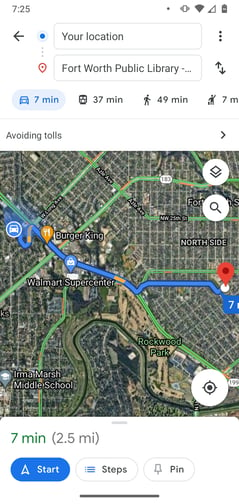
- Where are we?
- How did we get here?
- Where are we going?
As you jump in to help your teacher, working side by side as a collaborator, everything seems clear at the beginning. There are some obvious areas to address and both you and your teacher have tons of energy, ready to change the world. After a few visits, however, an unsettling feeling begins to creep up on you.
You don't know how to get off the coaching highway. You've never marked the exit.
For most of us, the meat of coaching comes in the classroom, working alongside the teacher. You're modeling, planning, co-teaching, and even observing. While that is where the real work is done, you'll never land the dismount until you know how to successfully map out the journey.
Before diving into the deep end with your teacher, it's imperative that you take time to map out your destination. How will you know when you’re finished coaching when you’ve never marked the finish line?
Aligned and purposeful
In my school district, we use a four-part model to describe strong coaching goals.
One component is aligned, which describes whether the coaching target is aligned to the department, school, or organization’s initiatives. All problems in a classroom cannot be addressed simultaneously, so some type of filter is needed. Aligning coaching to your organization’s priorities makes sure that your destination is a place you really want to go.

Instead of simply assuming that you and the teacher agree on an outcome, write a coaching goal that is aligned to your organization’s values and initiatives. Instead of using vague terms, name the CLASS dimension or indicator that you want to target.
Closely related to aligned is purposeful. Who wants to go there? If you, as a coach, are the only one that’s interested in meeting the coaching outcome, then you should be ready to provide the majority of the energy needed to meet the goal. If it isn’t meaningful to the teacher, they’ll come along as a passenger but will never jump into the driver’s seat.
I liken it to driving to a new location. If you're not sure how to get there, the first thing you do is take out your smartphone and look up the destination in your Google Maps app.
So if I wanted to go to the Northside Branch of the Fort Worth Public Library, I'd type it into my phone. That's the first step in the journey, the alignment and purpose of the coaching goal.
Timely
Closely related to alignment is another part of our four-part model, timely. How long should we be working on this coaching goal? Is it reasonable to complete it in three weeks? Three months? Without an estimated time of arrival, coaches can get off-track and not even know it.
That’s one reason why Google Maps is so helpful. Along with an overhead of the destination, it also gives an estimated travel time. This particular library branch is only 7 minutes away, so that’s not a problem. If there were no time estimates, I might have inadvertently picked a library in another county and only realized after I’d been on the road for awhile that it was too far.
In coaching, we have to know a reasonable time frame for closing out a coaching goal. Without this, we run the risk of getting stuck in an endless loop, unable to jump off the merry-go-round.
Use quantitative time references for when a goal should be accomplished. If merely creating a tool (e.g., anchor chart, small group schedule), set a date for it to be accomplished. If the goal is focused on integrating a new instructional technique (e.g., utilizing turn-and-talks, using reorientation statements), note a number of times, usually between two and four, that it should be observed.
Specific
Yet searching for a location on Google Maps only tells me where I'd like to go. Fixing a destination, or in this case a coaching outcome that is aligned, is simply the first step. While I might know where the library is and how long it’ll take me to get there, I’ve never been there. Which streets do I turn on?
Specific directions come from hitting the blue Directions button in the bottom left corner.
When I hit the Directions button, I see a route from my current location to the desired destination. I know, in a general sense, how I’ll work with my teacher to meet our coaching outcome.
And this is where many coaches get lost.
They look at the map and say to themselves, "Seems easy enough. Only 7 minutes away, just a few major streets." With confidence, they put their phones away and start driving into the coaching partnership. They start planning, modeling, and offering feedback.
Sometimes they can get there, either through a good memory or dumb luck. More often than not, however, they miss a turn. Coaches start to get sidetracked, chasing rabbits or missing obvious markers pointing to the outcome.
This happens because they never got specific, another part in our coaching goals model.
Knowing the destination is great and so is the estimated time of arrival. But how will you specifically get from Point A to Point Z? Where are the turns? What strategies will you use to aid the journey? Without answering those questions, you’re still coaching with one hand tied behind your back. If you were driving to an unknown destination, you wouldn’t just search for the place or even stop at Directions. You’d complete the process by hitting the blue Start button on your map app. That's what begins the turn-by-turn directions that assist you every step of the journey.
You want to increase Concept Development? You want to improve Instructional Learning Formats by the end of the month? Those are great destinations, but how will you do it? Within what content area or time during the day? What teaching strategies will you utilize to make it happen? Those questions answer the specific part of our model because those provide the structure needed to keep both you and your teacher from getting lost.
Even if you nail down a CLASS-related goal (e.g., increase concept development) and a reasonable time frame (e.g., observed in three coaching visits), it’s still easy to get lost without specifics. Name strategies that you will use to accomplish the goal (e.g., integrating at least two prediction questions into the morning read-aloud). If you meet the goal, great! If not, know you can go back and tinker with the specifics to see if there’s another avenue to try.
So, coach, if you find yourself getting lost in your coaching partnerships, you might want to ensure that you've actually started your navigation system. Decide on a coaching outcome that is aligned and purposeful (plugging in the destination), timely (getting the time estimate after pushing Directions), specific (pushing Start to begin navigation).
To see some strong coaching goals that meet these criteria, click here.
About the author:
Aaron Daffern has been a teacher, principal, and district administrator in the DFW area since 2000. He lives in Ft. Worth with his wife Heather and four lovely children. He has written four books about student engagement, vocabulary instruction, and high-impact instruction. Aaron also coaches educators and trains schools to better engage students. He currently serves as a manager in the Early Learning department of Dallas Independent School District. You can learn more about him at AaronDaffern.com.
